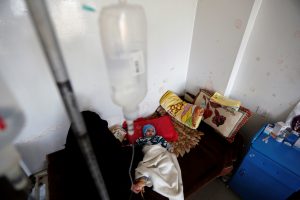
By Heekyong Yang and Josh Smith
SEOUL (Reuters) – While Seoul forges ahead with plans to use the upcoming Winter Olympics to showcase inter-Korean unity, some South Korean athletes are “furious” at proposals to form joint teams with North Koreans, highlighting a broader lack of enthusiasm for some of the government’s peace-making plans.
Officials from both countries are still engaged in talks over exactly how the North will participate in next month’s games in Pyeongchang. But the backlash may trip up Seoul’s plans to use the sporting event to improve bilateral ties after a year of high tensions over Pyongyang’s nuclear and missile programs.
South Korea’s women’s ice hockey team was the first to be singled out for possible integration with North Koreans, with Sports Minister Do Jong-hwan saying the government would ask Olympic organizers to expand the team’s roster from 23 to more than 30.
That came as a shock to team members, who had just returned to South Korea last Friday after training in the United States for the past three weeks, a senior official with the Korea Ice Hockey Association said.
“They were just furious and found the idea absurd,” the official told Reuters on condition of anonymity. “We are utterly speechless that the government just picked us out of blue and asked us to play with total strangers at the Olympics.”
The proposal has also sparked an outcry from thousands of South Koreans, who have signed online petitions asking the presidential Blue House to drop the idea.
“I cannot help but think the government is abusing its power to make political gains from the Olympics,” said one comment on the petition. “Taking roster spots from South Korean athletes who have put so much effort for the Olympics – a dream stage for all South Korean athletes – for the North Koreans is not fair at all.”
More than 70 percent of South Koreans oppose forming a joint team with the North, according to a Jan. 11 survey released by the office of the South’s National Assembly Speaker and television network SBS. More than 80 percent, however, said they welcomed the North’s participation in general.
A spokesmen for the Blue House referred questions to the ministries involved in the talks with North Korea.
The sports ministry said it was discussing the matter with the International Olympic Committee to “minimize any disadvantage” for the South Korean team.
“We will also be taking the public opinion into consideration prior to making the final decision,” a ministry official told Reuters. The unification ministry declined to comment.
INTERNAL DIVISION
The public backlash underscores how North Korea diplomacy, which has often come in the form of one-sided assistance from Seoul, remains a source of bitter division and contention within South Korea. The two countries are still technically at war because the 1950-53 Korean War ended in truce, not a peace treaty.
Liberal President Moon Jae-in wants to revive ties with North Korea that froze under nearly a decade of conservative rule in the South. His administration has proposed the two Koreas make a show of unity at the Games, marching together at the opening and closing ceremonies and competing together as one nation.
But South Korea’s ice hockey association hasn’t heard much from the politicians spearheading those plans, other than being told by the sports ministry to “get prepared,” the senior official said.
“Honestly, we have no idea what’s going on. Frankly, I do not know what they meant by to ‘get prepared’ since we do not have any channels to talk to the North Korean team,” the official said.
Among the issues to be worked out are the roster, game strategies and the appointment of a head coach to lead the joint team.
“None of these crucial and basic issues have been discussed at all. And the South Korean team’s first tournament in the Olympics is only three weeks away,” the official said. “Can you believe this? None of this makes any sense.”
The association did not make athletes available for interviews, saying they were in the final round of training before their first game on Feb. 10.
Sports Minister Do Jong-hwan has defended the proposal for a joint ice hockey team, arguing that by expanding the roster, no South Korean athletes would be left out.
South Korea will have the “coaching rights” for the team as well, he said during a parliamentary session on Monday, and the unified team would not “hurt South Korean athletes and their team capability.”
PUBLIC SKEPTICISM
Choi Moon-soon, governor of Gangwon province, where the games will be held, said the negative public views may be the result of frigid inter-Korean relations under previous conservative administrations. But he added that public opinion would change once North Korea attended the games.
“The two Koreas have marched at nine games so far, and the world gave its blessing to the two Koreas,” Choi said. “There were few people who opposed that.”
But Kim Dae, a 26-year-old engineer in Seoul, said there was no clear point in having a unified team.
“I do not understand what this united team is for. It almost feels like two different teams are forced to play together at the Olympics,” Kim said. “Who’s benefiting from this joint team anyway?”
A separate Jan. 8 poll by Realmeter found that 54 percent of South Koreans supported Seoul’s plans to provide accommodation and other expenses needed for the stay of the North Korean delegation during the games, while 41 percent opposed it.
Conservative lawmakers questioned whether the potential problems were worth the political gains.
“Many people worry that North Korea is taking advantage of the Pyeongchang Olympics to publicize its political propaganda,” parliament member Kim Ki-sun said on Monday. “How long did the peace last after the two Koreas marched together in past games?”
(Additional reporting by Hyunjoo Jin; Editing by Soyoung Kim and Gerry Doyle)










